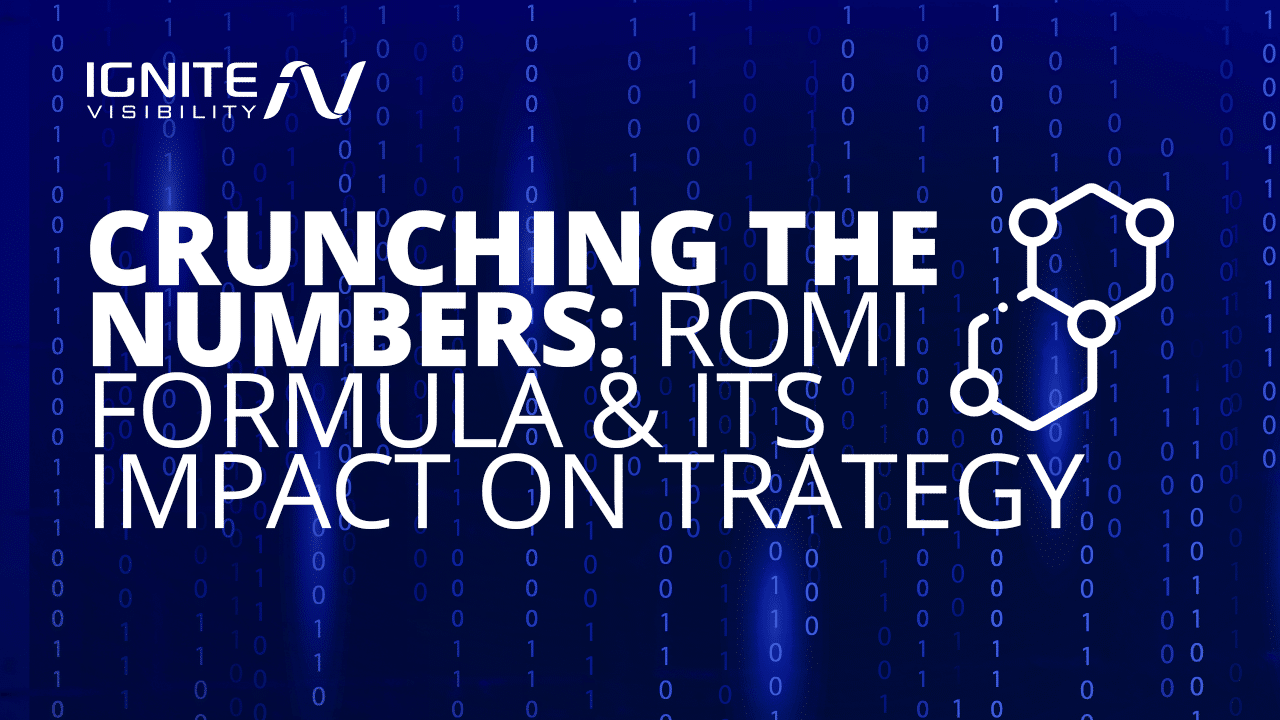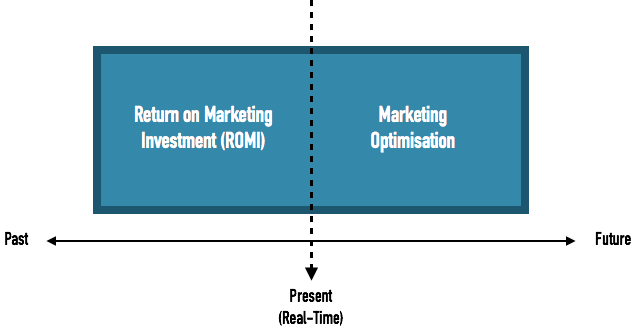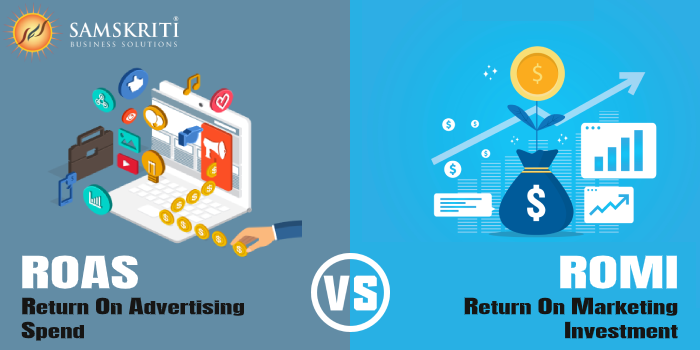
Return On Marketing Investment: ROMI
What is ROMI?
ROMI, or return on marketing investment, is a metric used to evaluate the effectiveness and profitability of marketing campaigns or initiatives. It measures the return generated from marketing activities, such as advertising or promotional campaigns, by comparing the revenue generated from the marketing initiative to the cost of that initiative.
It’s a type of metric that tells you the return on your investment, but ROMI is unique in that it focuses solely on marketing investments rather than sweeping investments.
The ROMI formula can vary depending on the specific context and goals of your marketing campaign. Generally, ROMI calculation involves subtracting the marketing investment from the revenue generated and then dividing that result by the marketing investment. The final result is often expressed as a percentage.
Your ROMI formula should look something like this:

ROMI Formula
Your ROMI factor will come out to be a number (either whole or by decimal depending on the result) or a percentile. To get a percentile, just multiply the factor by 100.
Here’s an example of how to calculate ROMI in real life:
ROMI = ($200,000 Revenue from Marketing Campaign – $50,000 Cost of Marketing Campaign) / $50,000 Cost of Marketing Campaign = 3 or 300%
If you’re lost on ROMI or you don’t want to spend the time and use up your staff just to get the metric, there are services that know how to calculate ROMI for you.
In many cases, it’s simple enough to determine on your own—but you can always refer to companies like Black Ink, which has a SaaS offering that measures ROMI for you.
How Does ROMI Helps Your Marketing Strategy?
The idea of ROMI has actually been around since before the turn of the century, but it’s definitely gaining steam in recent years—and for good reason.
Now, it’s not just seasoned thought leaders writing about ROMI.
Once you know your ROMI, you have a good idea of whether you’re in the red or green in terms of marketing investments. You can also tell how much you’re earning based on this “risked” capital.
With the results of your calculation in hand, you can determine pivots and trajectory for your marketing strategy moving into the upcoming quarter (and yes, I highly recommend addressing marketing metrics on a quarterly basis).

Return on Marketing Investment Diagram
Basically, you want to figure out just how effective your efforts are now and how they might affect your company down the line. You can be more efficient with your time and maximize your marketing team’s productivity. Plus, you can distribute your resources where they’re going to be most productive. With that in mind, ROMI just makes sense.
Who Should Pay Attention to ROMI?
ROMI (Return on Marketing Investment) is a metric that should be paid attention to by various parties within an organization, including:
- Marketing managers are interested in ROMI as it helps them evaluate the effectiveness of their marketing campaigns and initiatives. By measuring the return generated from marketing investments, they can assess the efficiency of their strategies, make data-driven decisions, and allocate resources effectively.
- Senior marketing executives have a vested interest in ROMI as it provides insights into the overall performance and profitability of the marketing department. ROMI helps them justify marketing budgets, prioritize marketing activities, and demonstrate the impact of their campaigns on the organization’s bottom line.
- The finance department pays attention to ROMI as it enables them to evaluate the financial impact of marketing investments and assess their alignment with the organization’s financial goals. ROMI helps in budget allocation decisions and tracking the return on marketing spend.
- Business owners and executives have a keen interest in ROMI as it provides them with an understanding of how effective their marketing efforts are at generating profits. ROMI helps in assessing the overall marketing strategy and guiding decisions related to investment in marketing activities.
- Stakeholders and investors are interested in understanding the effectiveness of marketing campaigns as it has implications for the financial performance and growth of the organization. ROMI provides insights into the marketing department’s contribution to the company’s profitability and market position.
ROMI For Long-Term and Short-Term Effectiveness
ROMI can be used to assess both short-term and long-term marketing effectiveness.
Short-Term Effectiveness
ROMI can provide insights into the immediate impact of marketing campaigns or activities. By comparing the revenue generated from a specific campaign to the cost of that campaign, marketers can determine the short-term profitability and effectiveness of their efforts. This allows them to analyze which campaigns are delivering immediate results and adjust their strategies accordingly.
For example, a company runs a short-term promotional campaign during the holiday season, spending $10,000 on advertising. The campaign generates $30,000 in sales. The ROMI for this campaign is calculated as ($30,000 – $10,000) / $10,000 = 2 or 200%. This indicates that for every dollar invested in the campaign, the company received a $2 return in the short term.
Long-Term Effectiveness
ROMI can also be used to assess the long-term effectiveness of marketing initiatives. By tracking the impact of ongoing marketing investments over an extended period, marketers can determine how successful their long-term strategies are in driving revenue growth and customer acquisition.
For example, a company invests in brand-building activities and customer retention programs consistently over a year, with a total marketing investment of $500,000. At the end of the year, the company’s revenue increased by $2 million. The ROMI for the long-term marketing strategy is calculated as ($2,000,000 – $500,000) / $500,000 = 3 or 300%. This suggests that for every dollar invested in the long-term marketing strategy, the company received a $3 return over the year.
By considering ROMI for both short-term and long-term effectiveness, marketers can gain a comprehensive understanding of the efficiency and profitability of their marketing activities.
This enables them to make informed decisions, optimize their strategies, and allocate resources effectively for both immediate gains and sustained growth.
ROMI vs. Other Marketing Metrics
ROMI provides valuable insights into the financial impact of marketing activities by calculating the return generated from marketing investments.
However, it’s important to consider other metrics in conjunction to gain a comprehensive understanding of marketing effectiveness.
Metrics such as ROI, CAC, CPL, CLTV, and conversion rate provide additional perspectives on different aspects of marketing performance.
By analyzing and interpreting multiple metrics together, marketers can make informed decisions, optimize strategies, and allocate resources effectively.
Let’s explore ROMI in comparison to other marketing metrics, highlighting their unique contributions and how they collectively contribute to evaluating marketing effectiveness.
ROMI vs. ROI
ROMI (Return on Marketing Investment) and ROI (Return on Investment) are related metrics used to evaluate the financial performance of marketing efforts, but there are some differences between them.
ROI is a broad financial metric that measures the overall return generated from any investment, including marketing. It is a measure of the profitability of an investment and considers the total gains and costs associated with that investment.
On the other hand, ROMI calculates the return on marketing investment specifically. It focuses on evaluating the financial impact of marketing activities by measuring the revenue generated from those investments.
While ROI is a more general metric that can encompass all investments, including marketing, ROMI specifically measures the return on marketing investments.
ROMI vs ROAS
ROAS (Return on Ad Spend) and ROMI (Return on Marketing Investment) are both metrics used to measure the effectiveness and efficiency of marketing activities, but they focus on different aspects of performance.
ROAS is a metric commonly used in digital advertising to evaluate the revenue generated from advertising spend.
It measures the effectiveness of specific advertising campaigns by calculating the revenue generated for every dollar spent on advertising.
On the other hand, ROMI is a broader metric that encompasses all marketing investments, not just ad spend. It measures the overall return on marketing investment by taking into account all marketing expenses and the resulting revenue generated.
ROMI provides a more comprehensive view of the financial impact of marketing efforts, considering various channels and activities beyond just advertising.
While calculating ROAS specifically focuses on the revenue generated from ad spend, ROMI takes a more holistic approach by considering the entire range of marketing investments and their corresponding returns.
Should You Go Even More Nuanced?
The ROMI calculation allows for a more educated strategy than metrics like ROAS and ROI.
However, not all marketing investments are created equally. Sometimes, it’s nice to know how different marketing objectives are performing in terms of profit.
In one of his books, Rex Briggs actually coined the term ROMO for return on marketing objective. This gives marketers space to have different metrics associated with different marketing objectives. Not all of these metrics are related to profit, either. Some have to do with brand awareness or brand perception.
Additionally, you can separate ROMI by campaigns or where those campaigns lie in the funnel (i.e. top of the funnel initiatives like social media tags or organic site traffic, or bottom-of-the-funnel initiatives like sales and conversions).
But if you haven’t delved into ROMI marketing, you should definitely start there. Once you get comfortable, you can always dig deeper into the data.
(Keep in mind that getting too laser-focused on data might jumble your marketing efforts, so use it as a guide—but not a be-all-end-all.)
FAQs: ROMI
1. Why is ROMI becoming a preferred metric for marketers?
ROMI is becoming a preferred metric for many marketers because it provides a more comprehensive measurement of marketing effectiveness, allows for better resource allocation and budget optimization, enhances accountability and justification of marketing investments, and is easier to calculate in the digital era.
2. How frequently should I analyze my ROMI?
The frequency at which you should analyze your ROMI depends on various factors, including your marketing objectives, the nature of your business, and the length of your marketing campaigns.
For short-term campaigns or initiatives, it may be helpful to analyze ROMI on a weekly or monthly basis. This allows you to capture any immediate trends, make timely adjustments, and optimize your marketing strategies.
For longer-term marketing efforts or overall brand strategies, it may be more appropriate to analyze ROMI on a quarterly or annual basis.
By analyzing ROMI over a longer timeframe, you can identify trends, evaluate the overall effectiveness of your marketing strategy, and make informed decisions about future resource allocation.
3. Are there industries where ROMI is more critical?
ROMI can be valuable in various industries and sectors. For example:
- Retail companies often invest significant resources in marketing to drive traffic, increase sales, and build customer loyalty.
- CPG companies heavily rely on marketing to promote their products, increase brand awareness, and drive sales.
- Telecommunications companies invest heavily in marketing to acquire new customers, retain existing ones, and promote new services.
- In the financial services industry, marketing plays a crucial role in attracting customers, building trust, and promoting various financial products and services.
- Technology companies often invest significant amounts in marketing to build brand awareness, generate leads, and drive product adoption.
ROMI analysis enables companies across a wide range of industries to evaluate the effectiveness of their marketing initiatives, optimize their marketing budgets, and identify the most successful customer acquisition channels.
4. What tools are best for tracking and analyzing ROMI?
There are several tools available for tracking and analyzing Return on Marketing Investment (ROMI). Here are some popular options:
Zebra BI: Zebra BI provides a comprehensive understanding of ROMI and offers tools for measuring and analyzing the impact of marketing campaigns.
Brand Finance: Brand Finance offers tools for measuring ROMI and determining the financial value attributable to specific marketing initiatives.
Improvado: Improvado provides tools for calculating ROMI and determining the revenue generated compared to marketing spending.
Optimization Group: Optimization Group offers ROMI analysis tools to help organizations understand the effectiveness of their marketing spending.
Dashly: Dashly provides tools for calculating ROMI and offers a ROMI calculator for easy online calculations.
These tools can help businesses track and analyze the return on their marketing investment, allowing them to make data-driven decisions and optimize their marketing strategies.
5. How can I improve my ROMI over time?
Improving Return on Marketing Investment (ROMI) requires a combination of strategic planning, data analysis, and continuous optimization. Here are some strategies to help you improve your ROMI over time:
- Set specific and measurable objectives: Clearly defining your marketing objectives allows you to focus your efforts and track progress.
- Track and analyze data: Tracking key performance indicators (KPIs) such as conversion rates, customer acquisition costs, and customer lifetime value helps you understand the effectiveness of your marketing efforts and identify areas for improvement.
- Segment your target audience: Analyzing and segmenting your target audience allows you to tailor your marketing messages and strategies to specific customer segments.
- Test and optimize your campaigns: Conduct A/B testing and optimize your campaigns based on data-driven insights, such as adjusting messaging, refining target audience selection, or optimizing media channels.
- Invest in marketing analytics: Utilize marketing analytics tools and platforms to gain deeper insights into your data and optimize your marketing efforts.
- Foster collaboration between marketing and finance: Establish strong communication and collaboration between your marketing and finance teams.
- Evaluate and adjust marketing spend: Regularly assess the performance of different marketing channels and campaigns to identify where your marketing dollars are delivering the highest ROMI.
- Focus on customer retention: Increasing customer retention helps improve ROMI by maximizing the value of your initial customer acquisition investments.
6. Is ROMI relevant for both online and offline marketing campaigns?
ROMI is applicable to both online and offline marketing campaigns because it helps assess the financial impact of these activities. Whether it’s an online campaign that aims to drive website traffic and conversions or an offline campaign that targets local audiences through billboard advertisements, ROMI can provide insights into the return on the marketing investment made in these efforts.
Tracking ROMI for both online and offline campaigns allows businesses to understand which channels and strategies are driving the most revenue or delivering the highest returns. This information helps optimize marketing budgets, make data-driven decisions, and allocate resources effectively to maximize overall ROI.
7. How does seasonality affect ROMI?
Seasonality can have a significant impact on return on marketing investment (ROMI). Consumer behavior and purchasing patterns tend to vary seasonally, influenced by factors like holidays, weather, and cultural events. Understanding and accounting for seasonality is crucial for optimizing marketing strategies and improving ROMI.
When it comes to seasonality, businesses should consider the following factors:
- Consumer Demand: Seasonal fluctuations can impact consumer demand for products or services. By aligning marketing efforts with peak seasons, businesses can capitalize on higher consumer demand.
- Marketing Planning: Identifying the key seasons or events that impact consumer behavior allows marketers to plan campaigns and allocate resources more effectively.
- Budget Allocation: By aligning marketing expenditures with peak seasons and adjusting budgets accordingly, businesses can optimize their ROMI during high-demand periods.
- Timing of Campaigns: Considering seasonality, businesses can plan and execute campaigns during periods when customer interest and engagement are highest.
- Channel Selection: Different seasons may present opportunities and challenges for specific channels. By analyzing historical data and customer behavior, businesses can choose the most appropriate channels for specific seasons.
Start Measuring ROMI Now
In a competitive and ever-evolving digital landscape, Ignite Visibility can be the catalyst that propels your business forward.
Our data-driven approach ensures that every marketing decision is backed by insights and analysis, maximizing the efficiency and effectiveness of your campaigns.
Ignite Visibility can help you:
- Increase brand awareness
- Develop ecommerce strategies to increase ROI
- Drive website traffic
- Generate leads
- Boost conversions
- And so much more!
